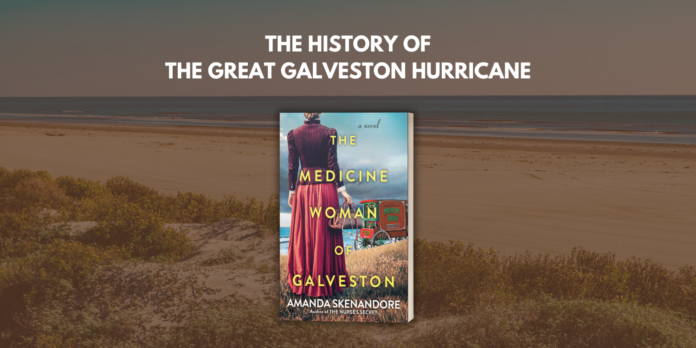I was well into adulthood before I heard about the Great Galveston Hurricane of 1900. After reading it was the deadliest natural disaster in United States history, with an estimated death toll between 6,000-12,000 people, I was curious to learn more. Here are some of the fascinating things I discovered:

- At the turn of the twentieth century, Galveston was a booming Gulf port, trailing only New Orleans in prominence. It was Texas’s fourth-largest city and the third richest city in the United States in proportion to population. The Strand, its main downtown thoroughfare, was dubbed the “Wall Street of the South.” The devastating 1900 hurricane, however, altered its fate. Despite rebuilding, Galveston never reclaimed its former glory.
- Although hurricanes had struck the island before, many people believed prior to the 1900 storm that it was impossible for a hurricane in the region to gather enough strength to significantly damage the city.
- At one point during the storm, eyewitnesses reported the water around their houses rising four feet in a matter of seconds. At their height, floodwaters in some parts of the city reached an estimated 20 feet.
- The wind was a particularly destructive force during the storm. Gusts are estimated to have reached between 120-145 miles per hour. It felled trees, ripped slate shingles from the roofs, and sent the timber from fallen homes flying. Many people were killed after being struck by airborne debris.
- Several hundred feet of beach were permanently swallowed in the gulf during the storm.
- Two railroad bridges and a wagon bridge connected Galveston Island to the mainland in 1900. All were destroyed by the hurricane, delaying much-needed aid to the survivors.
- Although the practice of categorizing hurricanes (1-5) was not established until the 1970s, it is believed the Galveston hurricane would have been a category 4 storm. Similarly, the hurricane is unnamed, as that convention did not begin until 1953.
- The storm’s floodwaters left an immense wall of debris. It rose several feet high and stretched 30 blocks.
- After the storm, the city erected a 17-foot-tall concrete seawall for protection against future storms. Unfortunately, due to climate change, sea levels in Galveston are rising faster than almost anywhere else in the world. Experts worry that another hurricane could overwhelm the seawall and, once again, destroy the city. Efforts are underway to build a higher seawall and miles of man-made dunes to protect the island.
THE MEDICINE WOMAN OF GALVESTON
Caught in the great Galveston Hurricane of 1900, a female doctor who’s joined a traveling medicine show to support her disabled son is forced to weather the storm and its aftermath in a town hostile to the troupe’s unconventional ways but desperate for their help.
Readers of Ellen Marie Wiseman, Sandra Dallas, and Sara Donati will be captivated by this story of medical historical fiction by Amanda Skenandore, registered nurse and acclaimed author of The Nurse’s Secret and The Second Life of Mirielle West.
Once a trailblazer in the field of medicine, Dr. Tucia Hatherley hasn’t touched a scalpel or stethoscope since she made a fatal mistake in the operating theater. Instead, she works in a corset factory, striving to earn enough to support her disabled son. When even that livelihood is threatened, Tucia is left with one option—to join a wily, charismatic showman named Huey and become part of his traveling medicine show.
Her medical license lends the show a pretense of credibility, but the cures and tonics Tucia is forced to peddle are little more than purgatives and bathwater. Loathing the duplicity, even as she finds uneasy kinship with the other misfit performers, Tucia vows to leave as soon as her debts are paid and start a new life with her son—if Huey will ever let her go.
When the show reaches Galveston, Texas, Tucia tries to break free from Huey, only to be pulled even deeper into his schemes. But there is a far greater reckoning ahead, as a September storm becomes a devastating hurricane that will decimate the Gulf Coast—and challenge Tucia to recover her belief in medicine, in the goodness of others—and in herself.
Reprinted with permission from Kensington Books.







